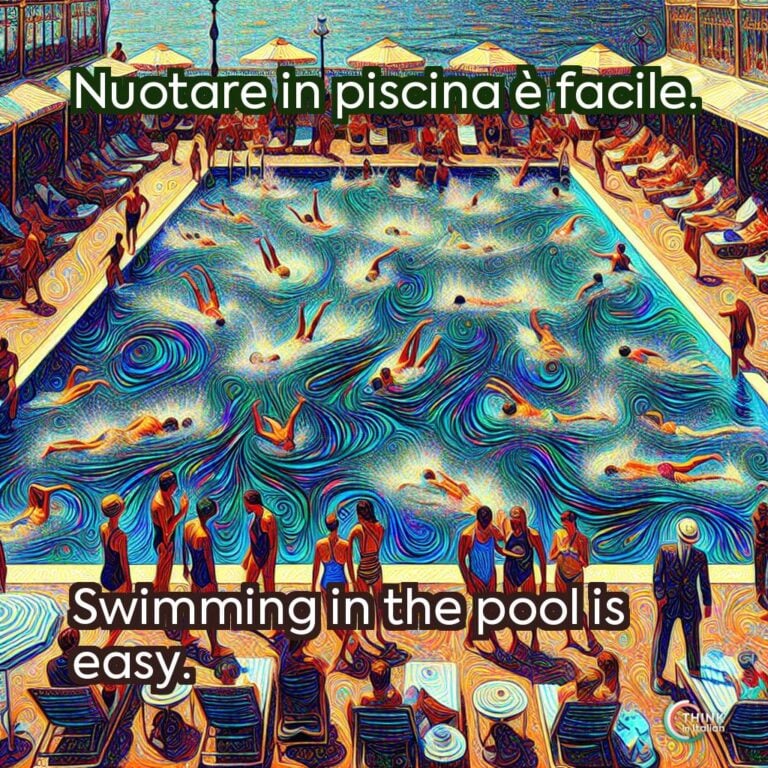What does è facile mean in Italian?
You probably know the expressions è facile (it’s easy) and è difficile (it’s difficult) in Italian.
These expressions are always followed by a verb in the infinitive form (imparare, cucinare, fare, etc.) but you might have noticed that sometimes we use the preposition da before the verb, like so: è facile da + verb or è difficile da + verb.
Let’s have a look at some examples:
È facile imparare l’italiano.
Learning Italian is easy.
L’italiano è facile da imparare.
Italian is easy to learn.
È difficile preparare questa torta.
It is difficult to prepare this cake.
Questa torta è difficile da preparare.
This cake is difficult to prepare.
How to use one or the other?
The use of the preposition da with expressions like è facile and è difficile depends on the position of the object in the sentence.
To understand the difference, we need to learn to recognize the object of a sentence first. The object of a sentence is the person or thing that receives the action of the verb.
In the following sentences, you will find the object of the sentence in bold:
È facile imparare l’italiano.
L’italiano è facile da imparare.
È difficile preparare questa torta.
Questa torta è difficile da preparare.
Have you noticed?
When we use è facile and è difficile without the preposition da, the object comes after the verb (imparare l’italiano, preparare questa torta), while when we use è facile da and è difficile da the object of the sentence comes before the verb.
When to use è facile or è facile da?
- È facile… or è difficile…
There are two ways in which we can structure this expression: È facile or È difficile + verb (imparare) + object (l’italiano) or
Verb (imparare) + object (l’italiano) + è facile or è difficile.
It doesn’t matter if the expression è facile / è difficile is at the beginning or at the end of the sentence. The rule does not change as long as the verb still comes before the object.
By the way, the expressions è facile / è difficile are impersonal, so they are always used in the singular.
- È facile da… or È difficile da…
Since the expression here is not impersonal but describes the object directly, we will have to conjugate the verb essere and change the number of facile or difficile according to the the person or thing that receives the action of the verb in the sentence:
Le lingue romanze sono facili da imparare.
Romance languages are easy to learn.
Gli sport acquatici sono difficili da praticare.
Aquatic sports are difficult to practice.
So…
- Singular object (l’italiano) + è facile da or è difficile da + verb (imparare).
- Plural object (le lingue romanze) + sono facili da / sono difficili da + verb (imparare)
By the way, adding a negative to the expressions doesn’t change the rule at all, so you can also say:
Non è facile imparare l’italiano.
It isn’t easy to learn Italian.
Le lingue romanze non sono difficili da imparare.
Romance languages are not difficult to learn.
È facile o è facile da: examples
Let’s have a look at some more examples so that you get a grip on it.
While you read the sentences, try to locate the object of the sentence, and check if it is before or after the verb.
Suonare la chitarra è facile.
Playing the guitar is easy.
Il pianoforte è difficile da suonare.
The piano is difficult to play.
Preparare la pasta non è difficile.
Making pasta isn’t difficult.
Questi biscotti non sono facili da preparare!
These biscuits are not easy to make!
Important things to remember
Sometimes, it can be confusing to know when to use è facile or è facile da.
When we use è facile or è difficile without the preposition da, the object comes after the verb.
While when we use è facile da or è difficile da, the object comes before the verb.
Also, remember that the expressions è facile and è difficile are always used in the singular form.
On the other hand, when we use è facile da or è difficile da, we have to conjugate the verb essere and change the number of facile or difficile depending on the object of the sentence.
Finally, adding a negative to the expressions doesn’t change the rule at all.




